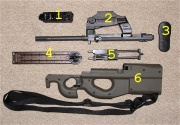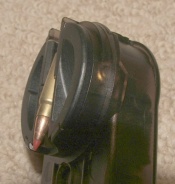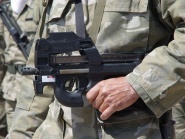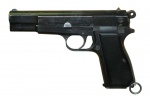Difference between revisions of "FN P90"
(Created page with '{{gun |name= P90 |image= FN-P90.JPG |caption= FN P90 LV/LIR with empty magazine |origin= Belgium |type= Personal defense weapon <!-- Specifications --> |length= 500 mm (1...') |
m (1 revision) |
Latest revision as of 16:26, 15 March 2013
| P90 | |
|---|---|
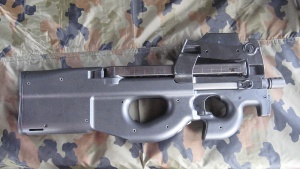
| |
| FN P90 LV/LIR with empty magazine | |
|
| |
| Type | Personal defense weapon |
| Land of Origin | Belgium |
| Specifications | |
| Length | 500 mm (19.7 in) |
| Barrel length | 263 mm (10.4 in) |
| Weight | |
| Width | 55 mm (2.2 in) |
| Height | 210 mm (8.3 in) |
| Cartridge | 5.7x28mm |
| Action | Straight blowback, closed bolt |
|
| |
| Rate of Fire | 900 RPM (cyclic) |
| Muzzle velocity | |
| Effective Range | 200 m (655 ft)[3] |
| Max. Range | 1,800 m (5,905 ft)[3] |
| Feed | 50-round detachable box magazine |
| Sights | Tritium-illuminated reflex sight, back-up iron sights |
| Service History | |
| In service | 1991–present |
| Used by | See Users |
| Wars | |
| Production History | |
| Design Date | 1986–1990 |
| Manufacturer | FN Herstal |
| Produced | 1990–present |
| Variants | See Variants: |
The P90 has a futuristic (some would say bizarre) appearance. It features a compact bullpup design and ambidextrous controls, and incorporates several innovations such as the top-mounted magazine and FN's high velocity 5.7x28mm ammunition. The P90 was developed between 1986 and 1990. A P90 TR variant was then introduced in 1999, featuring a triple rail interface system for mounting accessories. Since 2005, the P90 has also been offered to civilian shooters as the PS90, a semi-automatic sporting model with a lengthened barrel.
By 2003, the P90 was in use with military and police forces in over 25 countries worldwide.[4] In the United States, the P90 is currently in use with over 200 law enforcement agencies, including the Secret Service. The PS90 sporting model has also become popular with civilian shooters.[5]
Contents |
[edit] History
The P90 was developed by FN between 1986 and 1990 in conjunction with the 5.7x28mm cartridge. FN's goal was to replace the pistol-caliber submachine guns which were in use at the time by military and law enforcement personnel, as it had become evident that such weapons were ineffective against body armor.[2]
Initially the weapon was designed to use a 5.7x28mm cartridge called the SS90.[2] The SS90 propelled a 1.5-g (23 gr) plastic-core projectile from the P90 at a muzzle velocity of roughly 850 m/s (2,800 ft/s).[2] The first prototypes firing this ammunition were completed in 1987, and over 3,000 submachine guns were produced in this configuration until 1993, in a low-rate trial production mode.[6] Shortly after its introduction, the weapon was adopted and used in service with the Belgian special forces group in the 1991 Gulf War.
Following the P90's introduction, FN revised the 5.7x28mm ammunition and abandoned the SS90 variation.[2] The new variation, designated the SS190, used a projectile 2.7mm (0.11") shorter in length than that of the SS90.[2] This allowed it to be used more conveniently in the 5.7x28mm FN Five-seven pistol, which was under development at that time.[7] This projectile also had a heavier weight and more conventional construction containing an aluminium core and steel penetrator.[2][8][9] A modified version of the P90 with a magazine adapted to use the shortened ammunition was introduced in 1993. Several special cartridge variations were also developed, such as the L191 tracer round and the subsonic SB193 bullet for use with a sound-suppressed P90.[8]
Further development of the P90 platform led to the creation of the P90 TR variant, which has a MIL-STD-1913 top rail system. This variant was introduced in 1999 and continues to be offered alongside the standard P90. More recently, the P90 has been offered to civilian shooters, in various configurations, as the PS90. This is a semi-automatic sporting carbine with a lengthened 407 mm (16.0 in) barrel.[10]
[edit] Design details
The P90 is a selective fire straight blowback-operated weapon, that fires from a closed bolt.[11][1][2] The return mechanism consists of two parallel spring guide rods that also guide the bolt carrier assembly. The weapon's 263-mm (10.39 in) hammer-forged steel barrel is fitted with a ported, diagonally cut flash suppressor that also acts as a recoil compensator.[12]
The P90 is designed in the bullpup configuration, in that the action and magazine are located behind the trigger and alongside the shooter's face. This reduces the firearm's overall length, because there is no wasted space in the buttstock as in conventional designs. The P90 is fully ambidextrous — it can be operated by right or left-handed shooters with equal ease, and without making any modifications to the weapon. The charging handle, auxiliary fixed sights and magazine release are symmetrically distributed on both sides of the firearm. The manual fire selector below the trigger can be operated from either side. Spent cartridge casings are ejected downward through a chute located aft of the pistol grip, keeping fired cases out of the shooter's line of sight.[11][2]
The pistol grip has a thumbhole and oversized trigger guard that acts as the forward grip, and a protrusion is incorporated into the front of the weapon's stock to prevent the user from accidentally reaching out in front of the muzzle during firing.[2] The P90 is a modular firearm and consists of 69 parts that disassemble into four main groups: the barrel with integrated sight assembly, the receiver with return mechanism, the stock body with trigger and firing mechanism, and the magazine. The weapon's design makes extensive use of polymers and lightweight alloys to reduce both the weight and the cost of the weapon.[2]
The P90 uses an internal hammer striking mechanism and a trigger mechanism with a three-position rotary dial fire control selector, located at the foot of the trigger. The fire selector also provides a manual safety against accidental firing. The dial has three settings: "S" – safe, "1" – semi-automatic fire, and "A" – fully automatic fire. When set on "A", the selector provides a two-stage trigger operation similar to that of the Steyr AUG. Pulling the trigger back slightly produces semi-automatic fire and pulling the trigger fully to the rear produces fully automatic fire.[11][2] The "safe" setting disables the trigger.
[edit] Ammunition
- Main article: 5.7x28mm
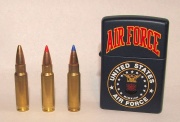
Particularly significant to the design of the P90 is the small caliber, high velocity bottlenecked cartridge it uses. The 5.7x28mm cartridge was created by FN in response to NATO requests for a replacement for the 9x19mm Parabellum cartridge. The cartridge weighs 6.0 g (93 grains), roughly half as much as a typical 9x19mm cartridge, allowing extra ammunition to be carried more easily.[13][14][15] The 5.7x28mm cartridge produces considerable muzzle blast and flash, but it produces roughly 30 percent less recoil than the 9x19mm cartridge, improving controllability.[14][15] It also exhibits an exceptionally flat trajectory.[14][16]
One of the design intents of the SS190 variation of this cartridge (not sporting variations) was that it have the ability to penetrate Kevlar protective vests, such as the NATO CRISAT vest, that will stop conventional pistol bullets.[15] The 5.7x28mm SS190 variation is capable of penetrating the CRISAT vest at a range of 200 m (655 ft).[15] It is also capable of penetrating a Level IIIA Kevlar vest at the same range.[16]
FN states that the P90 has an effective range of 200 m (655 ft) and a maximum range of 1,800 m (5,905 ft).[3] In testing in 1999 by the Royal Canadian Mounted Police (RCMP), the SS190 fired from the P90 at a distance of 25 m (82 ft) exhibited an average penetration depth of 25 cm (9.85 in) in ballistic gelatin covered with a Level II vest.[17] In testing done by Houston Police Department SWAT, the SS190 fired from the P90 typically exhibited 28 to 34 cm (11 to 13.5 in) penetration in bare ballistic gelatin.[16] The SS190 and similar 5.7x28mm projectiles have been shown to turn base over point ("tumble") in testing in ballistic gelatin and other media, using the 21.6-mm (.85 in) projectile length[18] to create a larger wound cavity.[1][13][16][19][20] However, some are skeptical of the bullet's terminal performance, and it is a subject of debate among civilian shooters in the United States.[20]
The 5.7x28mm projectiles are statistically safer than others, because the projectile designs limit overpenetration and the projectiles have a low risk of ricochet.[9][17][19] Since the SS190 projectile does not rely on fragmentation or the expansion of a hollow point, the cartridge (and 5.7x28mm weapons) are considered suitable for military use under the Hague Conventions of 1899 and 1907, which prohibit use of expanding or fragmenting bullets in warfare.[20]
[edit] Feeding
The P90 uses a unique horizontally-mounted feeding system that was patented in the United States. U.S. Patent 4,905,394 ("Top mounted longitudinal magazine") was awarded in 1990, naming René Predazzer as the sole inventor.[21] To allow the shooter to conveniently check the amount of ammunition remaining, the box magazine is composed of translucent polymer. The magazine is mounted parallel to the barrel, fitting flush with the top of the receiver. It contains 50 rounds, which lie in two rows pointed at a right angle to the barrel. As the cartridges are pushed forward by spring pressure and arrive at the end of the magazine, they are fed as a single row into a spiral feed ramp and rotated 90 degrees, aligning them with the chamber.[1][2]
[edit] Sights and accessories
The P90 was originally equipped with an unmagnified HC-14-62 reflex sight from Ring Sights, which enabled quick target acquisition up to 150 m (490 ft) and operation in low-level lighting conditions due to a tritium-illuminated aiming reticle. The current P90 is fitted with the Ring Sights MC-10-80 sight, which was designed specifically for the weapon.[1] It uses a forward-aimed fiber optic collector to illuminate the daytime reticle, which consists of a large circle of about 180 Minutes of arc (MOA), with a 20 MOA circle surrounding a dot in the center. The night reticle consists of an open "T" that is primarily illuminated by a tritium module or moonlight and ambient light drawn in by an upward-facing collector. The sight is adjustable for both windage and elevation and can be used with night vision equipment. Auxiliary fixed iron sights are provided on both sides of the receiver's cast aluminium optical sight housing.[1]
The P90 has provisions for mounting a number of different types of accessories, including tactical lights and laser aiming modules. It can also be fitted with various sound suppressors such as the Gemtech SP90, which was designed specifically for the P90. This stainless steel suppressor with a black oxide finish has a length of 200 mm (7.9 in), a diameter of 40 mm (1.6 in) and a weight 400 g (0.88 lb). When proper ammunition is used, it reduces the sound signature of the weapon by 33 dB.[3][22]
[edit] Variants
- P90 TR
- The P90 TR (Triple Rail) variant was introduced in 1999.[4] It features a receiver-mounted triple MIL-STD-1913 rail interface system, or "Triple Rail". There is one full-length rail on the top of the base and two rail stumps on the sides of the receiver. The side rails serve to mount accessories such as laser aiming devices or flashlights, while the integrated top rail will accept various optics with no tools or additional mounting hardware required.[12]
- P90 USG
- The P90 USG (United States Government) variant is similar to the standard P90 with the exception of a revised optic system, developed based on input from the United States Secret Service and other government agencies. The aluminium sight uses a non-magnified black reticle that does not require ambient light.[23]
- P90 Laserex models
- The P90 LV (Laser Visible) and P90 LIR (Laser Infrared) models add an integrated visible laser sight or infrared sight, respectively. They were introduced in late 1995.[24] Both units are manufactured by the Australian company Laserex Technologies. The laser's power switch is a green button located under the trigger grip. The lasers have three internal settings: "off" – to prevent accidental activation, "low-intensity" – for combat training and extended battery life, and "high-intensity" – for maximum visibility.[25]

[edit] PS90 sporting models
- The PS90 is a semi-automatic sporting version designed for the civilian market and introduced in late 2005.[10][26] It has an extended 407mm (16 in) barrel, an olive drab or black synthetic stock body, and an MC-10-80 reflex sight identical to that of the standard P90. The overall length of the PS90 is 667 mm (26.3 in). The barrel has eight rifling grooves with a right-hand twist rate of 1:178 mm (1:7 in), and a rifled length of 376 mm (14.8 in). It is equipped with a fixed "birdcage" type flash suppressor.
- The PS90's MC-10-80 sight can be removed and replaced with a special top rail for mounting third party optics, and the receiver assembly is drilled and tapped to accept accessory Picatinny rails on either side. The trigger pull is rated at approximately 31 to 36 N (7 to 8 lbf).[27] The PS90 weighs 2.9 kg (6.4 lb) empty and 3.4 kg (7.5 lb) with a fully loaded 50-round magazine.[26] It accepts the standard 50-round P90 magazines, but it is sold with a 10 or 30-round magazine, depending on local and state regulations.
- PS90 TR
- The PS90 TR uses a "Triple Rail" receiver assembly in the same fashion as the P90 TR. The standard back-up iron sights are no longer present, and instead, the top of the receiver is machined to form a Picatinny rail. Two plastic side-rails are included for mounting lasers or tactical flashlights. Like the standard PS90, the PS90 TR is available with either an olive-drab or black stock body.
- PS90 USG
- Another sporting variant is the PS90 USG. In the same fashion as the standard P90 USG, this variant replaces the PS90's MC-10-80 reflex sight with an unmagnified sight that has a black ring aiming reticle. Like other sporting models, the PS90 USG is offered with either an olive-drab or black stock body.
[edit] Users
Despite being originally intended as a defensive weapon for military personnel whose primary role is not fighting with small arms (such as vehicle drivers), most sales of the P90 have actually been to special forces and counter-terrorist groups who use it for offensive roles. The P90 first saw operational use in the 1991 Gulf War, with the Belgian special forces group. In 1997, suppressed P90s were used by the Peruvian special forces group (Grupo de Fuerzas Especiales; GRUFE) in the rescue of hostages in the Japanese embassy hostage crisis known as Operation Chavín de Huantar. By 2003, the P90 was in use by military and police forces in over 25 countries worldwide.
In the United States, Houston Police Department was the first local law enforcement agency to adopt the P90, acquiring it for their SWAT team in 1999. In 2003, the Houston SWAT team also became one of the first agencies in the country to use the weapon operationally in a shooting. By 2009, the P90 was in use with over 200 law enforcement agencies in the United States, including the Secret Service and Federal Protective Service. In response, the National Rifle Association added the P90 and PS90 to its NRA Tactical Police Competition standards, allowing law enforcement agencies to compete in the event using either weapon.[28] Military and law enforcement organizations using the P90 include:
| Table of users | ||||
|---|---|---|---|---|
| Country | Organization name | Model | Quantity | Date |
| Argentina | Agrupación de Buzos Tácticos tactical diver group of the Argentine Navy | P90 | — | — |
| Former Policia Aeronáutica Nacional (PAN; National Aeronautical Police) | P90 | — | — | |
| Austria | Jagdkommando (Jakdo) special group of the Austrian Army | P90, P90 TR | 140 | — |
| Kommando Militärstreife & Militärpolizei (Kdo MilStrf&MP) close protection teams | P90 TR | — | — | |
| Belgium | Composante Maritime (Belgian Navy) commandos | — | — | — |
| Composante Terre (Belgian Army) | — | 80 | 2004 | |
| Détachement d'Agents de Sécurité (DAS) dignitary protection group | P90 | 53 | — | |
| Directorate of Special Units (DSU) group of the Federale Politie/Police Fédérale | — | — | — | |
| Former Gendarmerie | P90 | 114 | — | |
| Special Forces Group (SFG; used in the 1991 Gulf War) | P90 | — | — | |
| Aarschot local police force | P90 | — | — | |
| Liège local police force | — | — | 2002 | |
| Zone de Police Boraine (Boussu/Colfontaine/Frameries/Quaregnon/Saint-Ghislain municipalities) police force | P90 TR | — | — | |
| Brazil | Batalhão de Operações Policiais Especiais (BOPE) of the Rio de Janeiro Military Police | — | — | — |
| Canada | Joint Task Force 2 (JTF2) special group of the Special Operations Forces Command | — | — | 2005 |
| Halifax Regional Police force in Halifax Regional Municipality, Nova Scotia | — | — | — | |
| Service de police de la Ville de Montréal (SPVM) SWAT in Montreal, Quebec | — | — | — | |
| Chile | Fuerzas Especiales (Special Forces) | — | — | — |
| Cyprus | Εθνική Φρουρά (Cypriot National Guard) special forces | P90 | 350 | 2000 |
| Czech Republic | Útvar Rychlého Nasazení (URNA) of the Police of the Czech National Police | — | — | — |
| Dominican Republic | Cuerpo de Ayudantes Militares del Presidente de la República | — | — | — |
| Dominican Republic's counter-terrorist group | — | 150 | 2002 | |
| Fuerzas Armadas de la República Dominicana (Military of the Dominican Republic) | — | — | — | |
| El Salvador | Comando Especial Antiterrorista (CEAT) | — | 350 | 2002 |
| France | 1er Régiment Parachutiste d'Infanterie de Marine (1er RPIMa) of the French Army | P90 | — | — |
| Commandement des Opérations Spéciales (COS) special operations group | — | — | — | |
| GIGN counter-terrorism group of the Gendarmerie Nationale | P90 TR | — | — | |
| GIPN counter-terrorism group of the Police Nationale | — | — | — | |
| RAID counter-terrorism group of the Police Nationale | — | — | — | |
| Troupes de marine naval infantry regiment of the Armée de Terre (French Army) | P90 | — | — | |
| Germany | Bundeskriminalamt (BKA; Federal Criminal Police Office) Sicherungsgruppe (SG; tasked with protection of the Chancellor of Germany (chancellor and other officials) | P90 TR | — | — |
| Greece | Ειδική Κατασταλτική Αντιτρομοκρατική Μονάδα (EKAM) unit of the Hellenic Police | — | — | — |
| Guatemala | Secretaría de Asuntos Administrativos de Seguridad de la Presidencia (SAAS) | P90 | 20 | 2009 |
| India | Special Protection Group (SPG; tasked with protection of the prime minister and other officials) | P90, P90 TR | — | 2008 |
| Indonesia | Komando Pasukan Katak (Kopaska) tactical diver group of the Indonesian Navy | — | — | — |
| Komando Pasukan Khusus (Kopassus) special forces group of the Indonesian Army | — | — | — | |
| Ireland | Sciathán Fianóglach an Airm (Army Ranger Wing) of the Irish Defence Forces | — | — | 2003 |
| Italy | Col Moschin 9º Reggimento d'Assalto Paracadutisti of the Italian Army | P90 TR | — | — |
| Jordan | — | — | — | — |
| Lebanon | Forces de Sécurité Intérieure (FSI) | — | — | — |
| Libya | — | — | 367 | 2008 |
| Luxembourg | Unité Spéciale de la Police (USP) group of the Grand Ducal Police | P90 TR | — | — |
| Malaysia | Pasukan Khas Laut (PASKAL) special operations group of the Royal Malaysian Navy | — | — | — |
| Mauritania | BASEP presidential security battalion | — | — | — |
| Mauritius | Various police forces | P90 | — | — |
| Mexico | Ejército Méxicano (Mexican Army) Special Forces | P90 | — | — |
| Estado Mayor Presidencial (EMP; Presidential Guard) | — | — | — | |
| Fuerzas Especiales (FES) of the Mexican Navy | — | — | — | |
| Policía Federal (PF; Federal Police) of the Secretaría de Seguridad Pública | — | — | — | |
| Netherlands | Korps Commandotroepen (KCT) of the Royal Netherlands Army | P90 TR | — | 2000 |
| Unit Interventie Mariniers (UIM) of the Netherlands Marine Corps | P90 TR | — | 2001 | |
| Pakistan | Special Service Group (SSG) of the Pakistan Army | — | — | — |
| Papua New Guinea | Papua New Guinea Defence Force | — | — | — |
| Peru | Grupo de Fuerzas Especiales (GRUFE) of the Peruvian Armed Forces | — | — | — |
| Fuerza de Operaciones Especiales (FOES) of the Peruvian Navy | P90 | 53 | — | |
| Philippines | Special Action Force (SAF) of the Philippine National Police | — | — | — |
| Poland | Grupa Reagowania Operacyjno-Manewrowego (GROM) special group | P90 TR | — | 2006 |
| Biuro Ochrony Rządu | P90 | 7 | 2007 | |
| Portugal | Grupo de Operações Especiais (GOE) of the Polícia de Segurança Pública | — | — | 2002 |
| Romania | Detaşamentul de Intervenţie Rapidă special operations group of the Romanian Military | — | — | — |
| Saudi Arabia | Special Emergency Force | P90 | 500 | 1992 |
| Singapore | Singapore Armed Forces Commando Formation | — | 500 | 2002 |
| Spain | Grupo Especial de Operaciones (GEO) of the Cuerpo Nacional de Policía | P90 TR | — | — |
| Ejército del Aire (Spanish Air Force) special units | P90 | — | — | |
| Suriname | Suriname Armed Forces | — | 900 | 2001, 2002 |
| Taiwan | — | P90 | — | 1992 |
| Thailand | กองทัพบกไทย (Royal Thai Army) special units | — | — | — |
| Trinidad and Tobago | Trinidad and Tobago Defence Force | — | — | — |
| Turkey | Prime Minister's close protection teams | — | — | — |
| Jandarma Özel tim-Özel Harekat Timi counter-terrorism group | — | — | — | |
| Ukraine | — | P90 LV | 30+ | 2008 |
| United States | Navy SEALs group of the United States Navy | — | — | — |
| US Federal Protective Service branch of the Immigration & Customs Enforcement | P90 | — | 2001 | |
| US Immigration and Naturalization Service | — | — | — | |
| US Secret Service | P90 TR | — | ~2000 | |
| Addison police department in Texas (first agency in the country to issue it to patrol cars) | PS90 TR | 52 | 2007 | |
| Alaska State Troopers in Alaska | P90 LV | 9 | — | |
| Birmingham Police Department SWAT in Alabama | P90 | — | — | |
| Bryan police department SWAT in Texas | — | — | — | |
| Creve Coeur police department in Missouri | — | — | — | |
| Edina police department in Minnesota | — | 11 | 2005 | |
| Houston Police Department SWAT in Texas (first local law enforcement agency in the country to adopt and use the weapon) | P90 | 5 | 1999 | |
| Kutztown police department in Pennsylvania | — | — | — | |
| Olathe police department ERT in Kansas | — | 23 | 2001 | |
| Passaic County sheriff's department SWAT in New Jersey | — | — | 2002 | |
| Richland County Sheriff's Department SRT in South Carolina | — | — | 2000 | |
| Sioux Falls Police Department SWAT in South Dakota | — | — | — | |
| Sparta Police Department in New Jersey | — | — | — | |
| Zapata County sheriff's department in Texas | — | — | — | |
| Venezuela | Bodyguards assigned to the Ministerio del Poder Popular para Relaciones Exteriores | — | — | — |
| Armada Bolivariana de Venezuela (Venezuelan Navy) | — | — | — | |
| Aviación Militar Venezolana (Venezuelan Air Force) | — | — | — | |
| Ejército Libertador de Venezuela (Venezuelan Army) | — | — | — | |
| Guardia Nacional de Venezuela (Venezuelan National Guard) | — | — | — | |
| Various police forces | — | — | — | |
[edit] Resources

This article has no links to any manuals whatsoever! This article needs more input to fill in those missing bits. You (yes, you!) can help Gunsopedia provide more comprehensive information to our users by submitting a manual that you might have. See this page to find out how you can contribute a manual to the Gun Owners' Resource Online Library and help your fellow gun owners. With your help, we really can make this a one-stop resource for all gun owners!

This article is either missing some diagrams which would help to illustrate a proper breakdown of the firearm in question or the diagrams which are here are inadequate. This article could use more input to fill in the missing bits. You (yes, you!) can help Gunsopedia provide more comprehensive information to our users by using your own knowledge to add to it.
[edit] Videos
↓ Video Slideshow ↓
[edit] See also
[edit] References
- ↑ 1.0 1.1 1.2 1.3 1.4 1.5 1.6 1.7 Miller, David (2001). The Illustrated Directory of 20th Century Guns. London: Salamander Books Ltd.. ISBN 9781840652451.
- ↑ 2.00 2.01 2.02 2.03 2.04 2.05 2.06 2.07 2.08 2.09 2.10 2.11 2.12 2.13 2.14 Marchington, James (2004). The Encyclopedia of Handheld Weapons. Miami: Lewis International, Inc.
- ↑ 3.0 3.1 3.2 3.3 Jones, Richard D.; Ness, Leland S., eds (January 27, 2009). Jane's Infantry Weapons 2009/2010 (35th ed.). Coulsdon: Jane's Information Group. ISBN 9780710628695.
- ↑ 4.0 4.1 Gourley, S.; Kemp, I (November 26, 2003). "The Duellists". Jane's Defence Weekly (ISSN: 02653818), Volume 40 Issue 21, pp 26–28.
- ↑ Fortier, David M (June 10, 2009). "Another caliber for your AR: 5.7x28mm". Shotgun News.
- ↑ "New P90 Round Puts FN on Road to the Next NATO Standard". International Defense Review (Switzerland), Volume 26 Issue 8 (August 1, 1993).
- ↑ The 5.56 X 45mm Timeline: 1990–1994. Watters, Daniel E., The Gun Zone
- ↑ 8.0 8.1 FNH USA Ammunition – FN 5.7x28mm. FNH USA
- ↑ 9.0 9.1 FNH USA 2008 Product Catalog - 5.7x28mm Ammunition
- ↑ 10.0 10.1 FNH USA Semi-Automatic Carbines — PS90. FNH USA
- ↑ 11.0 11.1 11.2 Hogg, Ian (2002). Jane's Guns Recognition Guide. Jane's Recognition Guides. Glasgow: Jane's Information Group and Collins Press. ISBN 9780007127603.
- ↑ 12.0 12.1 FN Tactical Weapons – FN P90. FNH USA
- ↑ Cite error: Invalid
<ref>tag; no text was provided for refs nameddettyTL2008 - ↑ 14.0 14.1 14.2 Big Scale Progress for Small Arms. Global Defence Review, 2002
- ↑ 15.0 15.1 15.2 15.3 Fortier, David. Military Ammo Today. Handguns Magazine, 2008
- ↑ Cite error: Invalid
<ref>tag; no text was provided for refs namedwall2003 - ↑ 17.0 17.1 Cutshaw, Charlie (May 2006). "FN Herstal's Five-seveN Pistol". Tactical Response.
- ↑ Sterett, Larry S. =FN 5.7mm Five-seveN Pistol Makes Civilian Model Debut. Gun Week, 2005
- ↑ Cite error: Invalid
<ref>tag; no text was provided for refs namedhumphries2008 - ↑ 20.0 20.1 20.2 Bahde, Dave. [FNH Five-seveN ODG 5.7×28mm. Combat Handguns, November 2009
- ↑ U.S. Patent 4,905,394 (Top mounted longitudinal magazine), United States Patent and Trademark Office
- ↑ Gemtech SP-90 suppressor. Jane's Infantry Weapons, May 22, 2008
- ↑ [FN Tactical Weapons – FN P90 USG. [[FNH USA]
- ↑ "Revolution in Slow Motion". International Defense Review (Switzerland), Volume 29 Issue 1, pp 13–14 (January 01, 1996).
- ↑ FN P90 Laser Target Designator. Remtek, 1999
- ↑ 26.0 26.1 Detty, Mike. FNH USA PS90 Carbine. Police Magazine, January 01, 2008
- ↑ Rodriguez, Greg. FN's Fun 5.7 Firepower. Shooting Times
- ↑ NRA Adds FN 5.7x28mm Caliber Firearms to Tactical Police Competition Standards. FNH USA
[edit] External links
- Official website
- Official website (FNH USA)
- Spring 2003 Experiences with the FN P90 (Tactical Response article)
- FN PS90 5.7mm Carbine (Law & Order article)
- FNH USA PS90 5.7x28mm (Special Weapons article)
- Ring Sights MC-10-80 specifications
- Official PS90 promotional video
| This article is part of a series on PDWs: modern personal defense weapons and cartridges | ||
|---|---|---|
| Personal defense weapons | Colt MARS · FN P90 · Heckler & Koch MP7 · Knight's Armament Company PDW · Magpul PDR · PP-2000 · QCW-05 · Saab Bofors Dynamics CBJ-MS · ST Kinetics CPW · VBR-Belgium PDW | |
| PDW-caliber pistols | FN Five-seven · Heckler & Koch UCP · QSW-06 · QSZ-92 · VBR-Belgium CQBW | |
| PDW cartridges | 4.6x30mm · 5.56x30mm MARS · 5.56x30mm MINSAS · 5.7x28mm · 5.8x21mm DAP92 · 6x35mm KAC · 6.5x25 CBJ-MS · 7.92x24mm | |
| This article is part of a series on FN Herstal firearms | ||
|---|---|---|
| Handguns | Barracuda · Five-seven · FNP series/FNX series · Forty-Nine · Hi-Power · HP-DA · M1900 · M1903 · M1905 · M1910 | |
| Rifles | Semi-auto & select — C1 · CAL · F2000 / FS2000 · FAL · FNAR · FNC · Model 1949 · PS90 · SCAR-L/SCAR-H Bolt-action — Model 1950 · Model 30-11 · PBR · SPR · TSR | |
| Shotguns | SLP · TPS | |
| Submachine guns | P90 | |
| Machine guns | BRG-15 · M2 · MAG· Minimi · Mle 1930 | |
| Other stuff | 5.56x45mm SS109 · 5.7x28mm · EGLM · FN 303 | |
| Handguns | M9 | M11 | MEU(SOC) | Mk 23 | Mk 24 | |
|---|---|---|
| Rifles | Assault and Battle | M16 | Mk 14 | Mk 17 |
| Carbine | HK416 | M4 | Mk 18 | |
| Designated Marksman | DMR | M14 | M39 | Mk 12 | SAM-R | SDM-R | SEAL Recon Rifle | |
| Sniper | M24 | M40 | M107 | M110 | Mk 11 | Mk 15 | |
| Shotguns | M26 | M590 | M870 | M1014 | |
| Submachine guns | MP5N | P90 | |
| Machine guns | M2HB (still!) | M240B | M249 and Mk 46 | Mk 43 | |
| Grenade launchers | M203 | M32 | M320 | M79 | Mk 19 | Mk 47 | |
| Mortars | M120 | M224 | M252 | |
| Rockets | M3 | M72 series | M136 | M141 | M202A1 | Mk 153 | |
| Missiles | FGM-172 | FGM-148 | FIM-92 | |
| Cartridges | 12-gauge | 5.7x28mm | 9x19mm NATO | .45 ACP | 5.56x45mm NATO | 7.62x51mm NATO | .50 BMG (12.7x99mm NATO) | 40x46mm | |
| This page is part of a series on: current French infantry weaponry | ||
|---|---|---|
| Handguns | PAMAS· MAC Mle 1950 | |
| Rifles | Assault rifles | FAMAS · SIG SG 550 (and variants) · HK 416 |
| Anti-materiel rifle | PGM Hecate II | |
| Sniper | FR F2 · FR F1 | |
| Shotguns | Benelli M4 | |
| Submachine guns | MP5 · P90 | |
| Machine guns | M2HB · AA52 · Minimi | |
| Grenade launchers | M203 · LGI | |
| Mortars | LLR 81mm · MO-120-RT-61 | |
| Rockets | LRAC F1 · ABL | |
| Missiles | MILAN · ERYX · Mistral | |
| Cartridges | 12-gauge · 5.7x28mm · 9x19mm NATO · 5.56x45mm NATO · 7.62x51mm NATO · 12.7x99mm NATO | |
